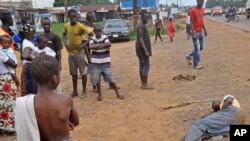In West Africa, the World Health Organization says the Ebola virus has so far infected over 3,700 people and killed over 1,800. There is no cure for disease, and a potential vaccine could be months, or years, away.
However, some health care professionals are looking at alternative approaches for helping Ebola patients survive the virus.
Sharing antibodies
One option gives an infected patient a transfusion of blood from those who have recovered from Ebola. Their plasma, the liquid part of the blood, contains antibodies that have successfully fought off the virus.
The process of separating the plasma – and its antibodies -- from the blood of survivors is called plasmapheresis.
Recently, an American doctor infected in Liberia, Kent Brantly, received a transfusion from an Ebola survivor. And, the New York Times cites a professor of virology in Nigeria who says the procedure is being considered using the blood taken from five survivors in the country.
Dr. David Heymann, a professor of infectious disease epidemiology at the London School of Hygiene and Tropical Medicine, says it was used in the 1970's during the first Ebola outbreak in Kikwit, in what was then Zaire – now the Democratic Republic of the Congo.
Dr. Heymann was involved in treating infected persons in that emergency, and also led a response team during another in Kikwit 19 years later.
"I stayed two and half months after the first Ebola outbreak in 1976 and did plasmapheresis on survivors [so] that that blood could be stored [at various points] around Africa," he said. "[It was used one time to treat a laboratory scientist in the UK who had been exposed to Ebola in a laboratory accident.] Then in 1995 in [another] Kikwit outbreak, the government decided that it would use [blood containing antibodies] collected from survivors to treat eight patients. Seven of them survived.
Dr. Heymann said it’s not clear whether the antibodies were behind the survival of the seven infected patients, and further study is necessary to verify the effectiveness of the procedure.
Readily available drugs
Another potential approach is to test existing drugs that may help Ebola patients. Many of these are generic and inexpensive. A New York Times editorial suggests medications that are already used to disable other viruses, as well as drugs that modulate the immune system’s inflammatory response.
That’s the defensive action taken by the body against the virus, which can sometimes lead to organ failure and other deadly complications.
Among these drugs is a class of drugs called statins, such as Lipitor, which reduce cholesterol.
Dr. Heymann and others support the approach of studying medicines shown to be effective against Ebola in animal studies."I think that before any medication could be used [to treat Ebola patients]," said Heymann, " it would need to be shown to be effective, at least in an animal model. They should not be used unless they are in a clinical trial setting [that can demonstrated whether they are effective in humans]. It’s the countries themselves that make the decisions [to allow these medications] and hopefully the [World Health Organization] would support their decision."
Effectivness of quarantines
Currently, some countries are quarantining neighborhoods and villages. They’ve also created road blocks and patrols to prevent infected persons from crossing borders. And some are proposing protective barriers or buffers around infected villages, called cordons sanitaires. Dr. Heymann says in his view, that’s not the most effective approach.
"All cordons sanitaires would do is stop [some persons with Ebola infection from moving, but also disrupt] legal and legitimate travel and commerce," he said. " But with porous borders [as in many African countries]…it could be setting up a feeling of false security. What’s more important is that everybody should understand the disease and how to deal with it.
"In the 1995 Kikwit outbreak, for example, the government of DRC put up a cordon sanitaire [to quarantine] the area where the outbreak was occurring. People, however, were just [moving out of] the area where there were no [roadblocks]…. [Some] went [to neighboring villages] by boat on a nearby river. "
Known remedy
Dr. Heymann said the best response was learned in Kikwit nearly 40 years ago. Stopping an outbreak means improving hospitals so infections do not spread to health workers and other patients -- and tracing everyone who’s come in contact with a person infected with Ebola. They would be put under surveillance and hospitalized if they develop a fever caused by the virus.
The community must also understand how the virus is spread. It’s transmitted by contact with the infected person’s bodily fluids, including vomit, urine or diarrhea. Transmission often occurs during care giving, transport, or as part of traditional burial practices that include touching the body.
According to Dr. Heymann, the outbreak would likely have been under control in Guinea earlier this year if these measures had been taken when Ebola was first detected.









